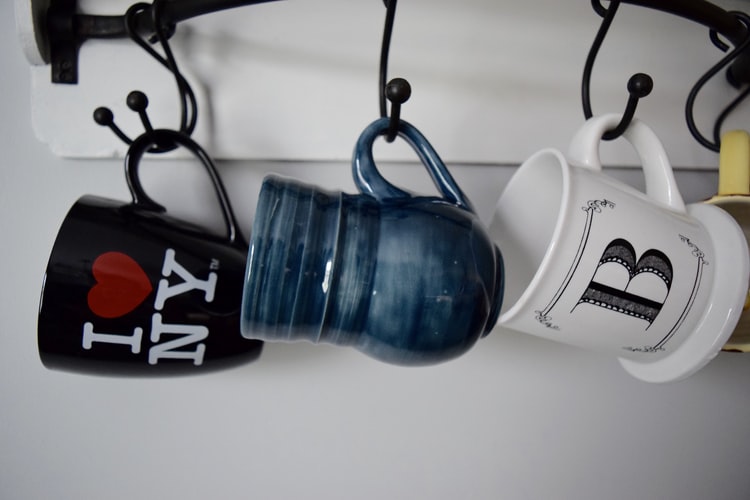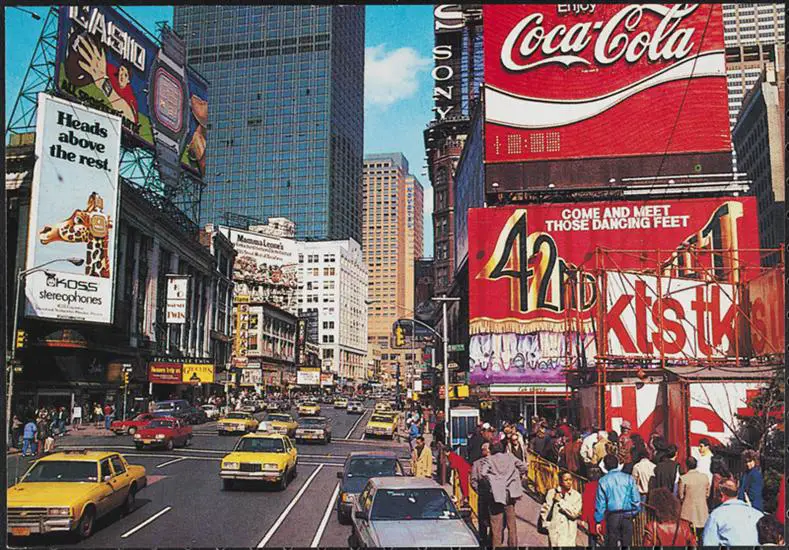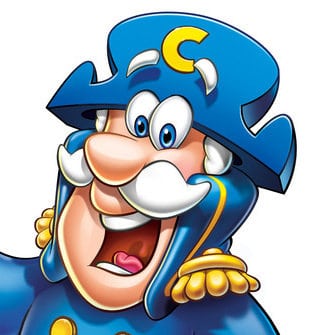
New York City has gone through alot–no surprise there. The city is also facing a lot of current scrutiny if it will recover from the pandemic. It took one of the city’s great residents — Jerry Seinfeld — to set people straight and let them know that, yes, New York will recover.
But New York has faced some worst circumstances including in the 70s and 80s. It would take one of the most famous advertising campaigns in history to bring it back from the dead.
The I Love New York campaign was put together by Wells-Rich-Greene to restore tourism to the city. The famous slogan–and logo–became one of the most famous tourism marketing campaigns of all time.
This is a look back on this historic campaign that saved a city, the famous logo, and why it’s one of the most important marketing campaigns of the 80s–and of all time.
My Own Story With New York City
NYC is very near and dear to my heart. In 2005 I went to work at a sports summer camp in Connecticut. This was only a few hours from the city and being that close meant days off, and weekends spent there.
A majority of the staff were from the New York area, and I met people that became some of my closest friends. This meant there were always places to stay in New York, so I got very familiar with the city. I’ve spent 13 summers there each year, and would stay in the area for at least 4 months.
I’ve been in New York for Christmas, New Yeras in Times Square, Thanksgiving, Spring, and any other time you can think of. I’ve had the fortune of feeling like a real New Yorker and know my way around parts of Manhattan better than my own city.
With friends living in the Upper West Side, the Upper East Side, mid-town, the East Village, the Lower East Side, etc, It really feels like a second home now.
It’s been really interesting to learn the state of everything going into the 80s, and how this city was considered the scum of the earth. And this takes us into the marketing campaign.
Why Many People Claimed to Have Created This Campaign
With anything successful, many people say they were responsible for its creation. The “I Love New York” campaign is no different. The campaign involved a lot of people, but the marketing campaign came down to two women.
The first is the godmother of advertising, Mary Wells Lawrence. But the one who really was the heart and soul behind the campaign is Jane Maas. Maas is considered the real-life inspiration for Peggy Olson from Mad Men.
Side note: If you’ve never watched Mad Men, leave this blog and don’t return until you finish this masterful series.
Maas has written several books on advertising, but her book, “Mad Women: The Other Side of Life on Madison Avenue in the 60s and Beyond,” is a brilliant look into the Mad Men culture, along with the story of her famous campaign.
Now, let’s look at how bad things were in New York coming out of the 1970s.
The State of New York City Going into the 80s

If you want a full history of New York City in the 80s, you need to check out my podcast interview with Greg Young. Greg is one of the hosts of the Bowery Boys–the definitie New York City podcast.
In the episode, Greg and I talk about the state of the economy, the politics, and the culture of New York City in the 80s. We also discuss the movies that take place there, the TV industry, and what the music scene was like then, too.
Check out the interview here:
New York has gone through many changes over its history, but in the ‘70s, it wasn’t exactly a shining beacon of light emerging from the East Coast. In 1975, the state, and the city, were nearly bankrupt. The city was seen as extremely dirty, expensive, crime-filled, and a dangerous place to visit.
We all knew the stories of the dangers of going into Central Park late at night, or that you shouldn’t ride the subway after dark either. There were certain neighbourhoods that you just wouldn’t step foot in.
Today, those same neighborhoods are now some of the most expensive real estate in the country.
If you’ve been to New York in the last few years, you know Times Square has turned into a mini DisneyLand. It’s for Families, tourists, and is one giant commercial. In the 70s and 80s, you would only go down there for very immoral activities.
Things are so bad that the city was almost broke. To avoid bankruptcy, the city turned to president Gerald Ford, who famously told New York to “drop dead.”
Everyone panicked and scrambled to improve their image and reputation. In order for New York to survive, they needed to increase tourism.
The Department of Commerce thought it would be a good idea to use an advertising agency to sell the state, and the City of New York, to a nationwide audience.
Many agencies turned down the opportunity for this project, but one ended up taking it: advertising agency “Wells Rich Greene,” which included Jane Maas.
Treating New York Like A Product & Not a City
This was the critical idea behind the success of the “I Love New York” campaign. Even though it was an overwhelming project, Maas stated how they had to think of New York as a product such as a bar of soap in order to sell it. They threw out any idea of tourism and treated it like a genuine product.
Here’s another great advertising campaign from the 80s I wrote about: Apple’s 1984 Commercial.
They knew they had a dirty and difficult to use product, but they had to sell people the idea that the state and city weren’t as bad as you heard in the media.
The agency decided that they had to start with market research before they even got into advertising. This was critical because they had to find out what brought tourists to New York, and more importantly, what kept them away.
The research showed that people view the state and the city as two entirely different products. New York State was more about families, nature, and summer vacations, and the city was more about culture. Manhattan appealed to older, more educated tourists with money to spend.
There was also one other key component that kept people coming back to the city, and would be instrumental in saving New York: Broadway.
Putting Together the “I Love New York” Campaign
“Wells Rich Greene” now had to put all this information together into an effective marketing campaign. It’s not like New York hadn’t been promoting itself, but it was so hard to get people to a city where you will probably be mugged.
The state and city had also been horrendous at promoting itself. They actually had the lowest marketing budget per capita of all 50 states.
The Department of Commerce allowed a $4.3 million budget for an advertising campaign — but they needed to get it out as quickly as possible.
New York City was hanging in the balance and really didn’t have much time to spare. It’s crazy to think how close this place was to essentially going under.
To get the summer vacation crowd–and families-they had to advertise months beforehand as most people make summer plans in the spring.
The first campaigns featured TV spots that showed people from other states coming into New York State and enjoying it. The commercial would feature lines like:
“I’m from Cape Cod, but I Love New York,” or, “I’m from New Hampshire but I Love New York.”
The main tagline for the commercial was “If you love the outdoors, you’ll love New York.”
Two Two Most Important Parts of the Campaign
The campaign looked good, but it took a few more things for it to be a success. The first was the jingle created for the commercial. But instead of going with the initial tagline, composer Steve Karmen simply called it: “I Love New York.” Have a listen to it here:
The famous–and iconic–“I Love New York” logo would be the last piece of the puzzle. It was designed by Milton Glaser who took his approach from the newly named song and used it as inspiration for his famous logo.
The logo was simple but effective and has become a pop culture icon. There have been countless imitations of it–for everything you can think of–in every part of the world.
There was one demand made by the Department of Commerce, though: They wanted the logo to be in the public domain. This meant that any attraction throughout the state could use it without charge.
The use of the logo over the years is worth untold millions, but it’s designer accepted a one time fee of just 1,000 dollars.
Ouch.
The Very Quick Success of the “I Love New York” Campaign
The commercials started airing in 1977 — and caught on quickly. People loved the jingle and the simple, but effective, logo. Jane Maas explains how the agency used an advertising technique called “roadblocking” that helped with the success of the promotion.
Roadblocking is making sure an ad runs during the evening news, at the same time period. Since there were only three networks then, anyone watching would see it.
The campaign worked so well that overnight gas stations were selling out of New York State maps. “I Love New York” bumper stickers started showing up on taxi cabs all over the city–and it didn’t take long for it to appear on t-shirts. It was a hit and
The research conducted by “Wells Rich Greene” showed that 90% of people in the target markets were aware of the campaign.
But that was just New York State; The other half of the campaign — New York City — was also seeing improvements in tourism pretty quickly. Since Broadway was seen as the big draw, theater packages were created that included tickets and a hotel room. The tourism packages also included a sightseeing trip, transportation, and even meals.
This was important because it took all the guesswork out of coming to this “dangerous city.” Those who loved Broadway and the arts could head in and not worry about all the details of where to stay, or where to eat, without getting a screwdriver stuck in their abdomen.
This great tourism package made it an easy sell–and people started coming in droves.
The whole campaign worked so well that it didn’t take long for New York to not even need to advertise anymore. In 2018, New York welcomed 65.2 million guests, generating $623 million just in estimated hotel occupancy tax revenue.
Final Thoughts on the “I Love New York” Tourism Campaign
New York is my favorite city on earth. I’ve been to a few of the world’s big cities, but New York takes the cake for me. I also live near Detroit, Michigan, and it’s been astounding to see the setbacks that they have faced.
New York was in the same precedent and the “I Love New York” campaign was able to capture the spirit of the city with perfect promotion.
The logo became one of the most famous in history, and is recognized by all walks of life. By the way,
New York City has always battled back. We know what they’ve been through, and they can never be held down.



